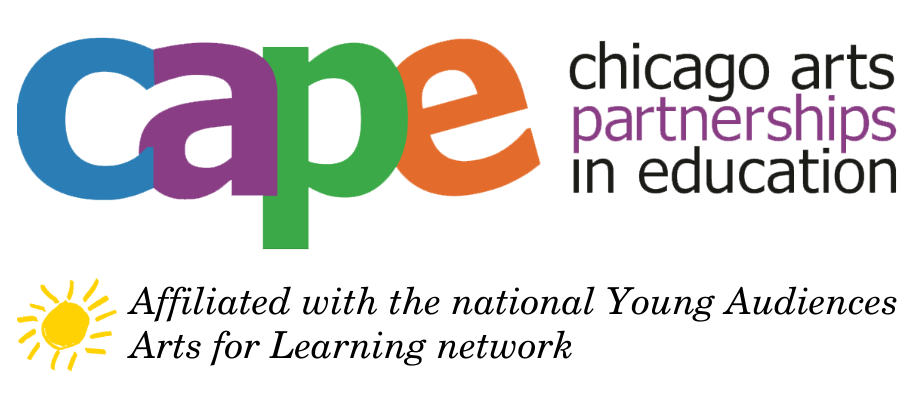Like John Legend and Common, Chicago Students Seek Social Justice through Music
Like John Legend and Common, these students use music to call for social justice in Ferguson, Gaza, Chicago, and beyond

Last spring, CAPE music teaching artist Ronnie Malley began working with Lindblom Math and Science Academy’s choir teacher, Casey Fuess. The two educators have both worked with CAPE for many years in other partnerships, but this year was their first time working together in our Veteran Partnerships program.
As Casey and Ronnie began brainstorming together in the spring of 2014, they knew they wanted to somehow explore, through music composition, the human rights injustices occurring in Gaza. However, as a result of the police shootings of unarmed black men in Ferguson and New York and the Black Lives Matter movement, the instructors realized that this project could have a much greater relevance for their students than they had originally imagined.
This fall, just like John Legend and Common, whose song ‘Glory’ has won a spate of awards including the Academy Award for Best Original Song, Casey and Ronnie’s students created songs in the tradition of voicing calls for justice through music.
Below are comments from Casey Fuess about this work with his Lindblom students:
How did the real world events impact your thinking and your teaching as the project progressed?
 The project was initially inspired by current events [in the spring of 2014, when our planning began]. When we designed this project, we challenged ourselves to consider how students on the South Side of Chicago could respond to the recent rise in Palestinian-Israeli tension in Gaza. We asked ourselves, “How can we humanize the struggles of others so far away from these students?” In the time from our initial planning to actual implementation, a number of troubling events occurred in the United States with similar implications/ themes for race/ cultural relations/ awareness: the death of Michael Brown, the death of Eric Garner, the attack on Charlie Hebdo, and continued violence in Gaza. Since Lindblom’s student body is majority African-American, the tragedy of Michael Brown and Eric Garner’s deaths–and the “Black Lives Matter” movement– had a particularly strong impact on students’ inquiry dialogue. They challenged each other to analyze these events and responded to them by writing artistic text (i.e., poetry, lyrics) and composing music.
The project was initially inspired by current events [in the spring of 2014, when our planning began]. When we designed this project, we challenged ourselves to consider how students on the South Side of Chicago could respond to the recent rise in Palestinian-Israeli tension in Gaza. We asked ourselves, “How can we humanize the struggles of others so far away from these students?” In the time from our initial planning to actual implementation, a number of troubling events occurred in the United States with similar implications/ themes for race/ cultural relations/ awareness: the death of Michael Brown, the death of Eric Garner, the attack on Charlie Hebdo, and continued violence in Gaza. Since Lindblom’s student body is majority African-American, the tragedy of Michael Brown and Eric Garner’s deaths–and the “Black Lives Matter” movement– had a particularly strong impact on students’ inquiry dialogue. They challenged each other to analyze these events and responded to them by writing artistic text (i.e., poetry, lyrics) and composing music.
Why is it important for students to do projects like this? What’s special about music and the arts, that benefits students as they tackle serious issues in the world today?
 The arts are at the foundation of how we understand ourselves, our culture, and with whom we share cultural bonds. We challenged the students to consider whom they viewed as the “other,” who viewed them as the “other,” and how this could be influenced by artistic creation. It took a few lessons for students to fully understand what we were asking of them– to understand that we weren’t asking them for some “correct” analysis of the events that we had predetermined. Instead, we asked them to respond artistically in ways that were authentic and thoughtful. As our students responded through artistic creation, we saw them take collective responsibility and concern for the way people represent themselves and others in the media and the arts. These students will be the policy makers, leaders, thinkers, and voters of tomorrow. Can the arts help them to develop a critical lens through which to view challenging world events? We believe the answer is a profound yes.
The arts are at the foundation of how we understand ourselves, our culture, and with whom we share cultural bonds. We challenged the students to consider whom they viewed as the “other,” who viewed them as the “other,” and how this could be influenced by artistic creation. It took a few lessons for students to fully understand what we were asking of them– to understand that we weren’t asking them for some “correct” analysis of the events that we had predetermined. Instead, we asked them to respond artistically in ways that were authentic and thoughtful. As our students responded through artistic creation, we saw them take collective responsibility and concern for the way people represent themselves and others in the media and the arts. These students will be the policy makers, leaders, thinkers, and voters of tomorrow. Can the arts help them to develop a critical lens through which to view challenging world events? We believe the answer is a profound yes.



